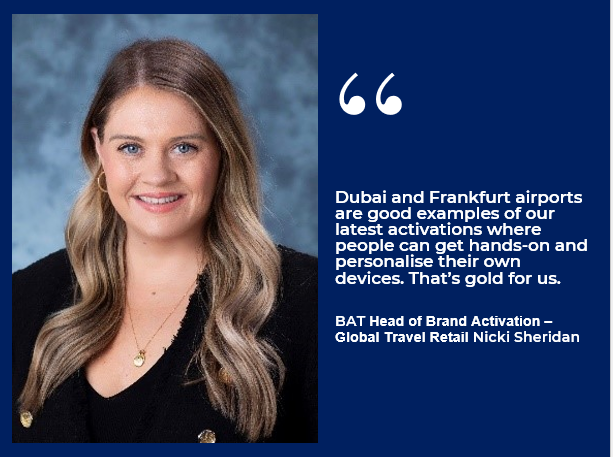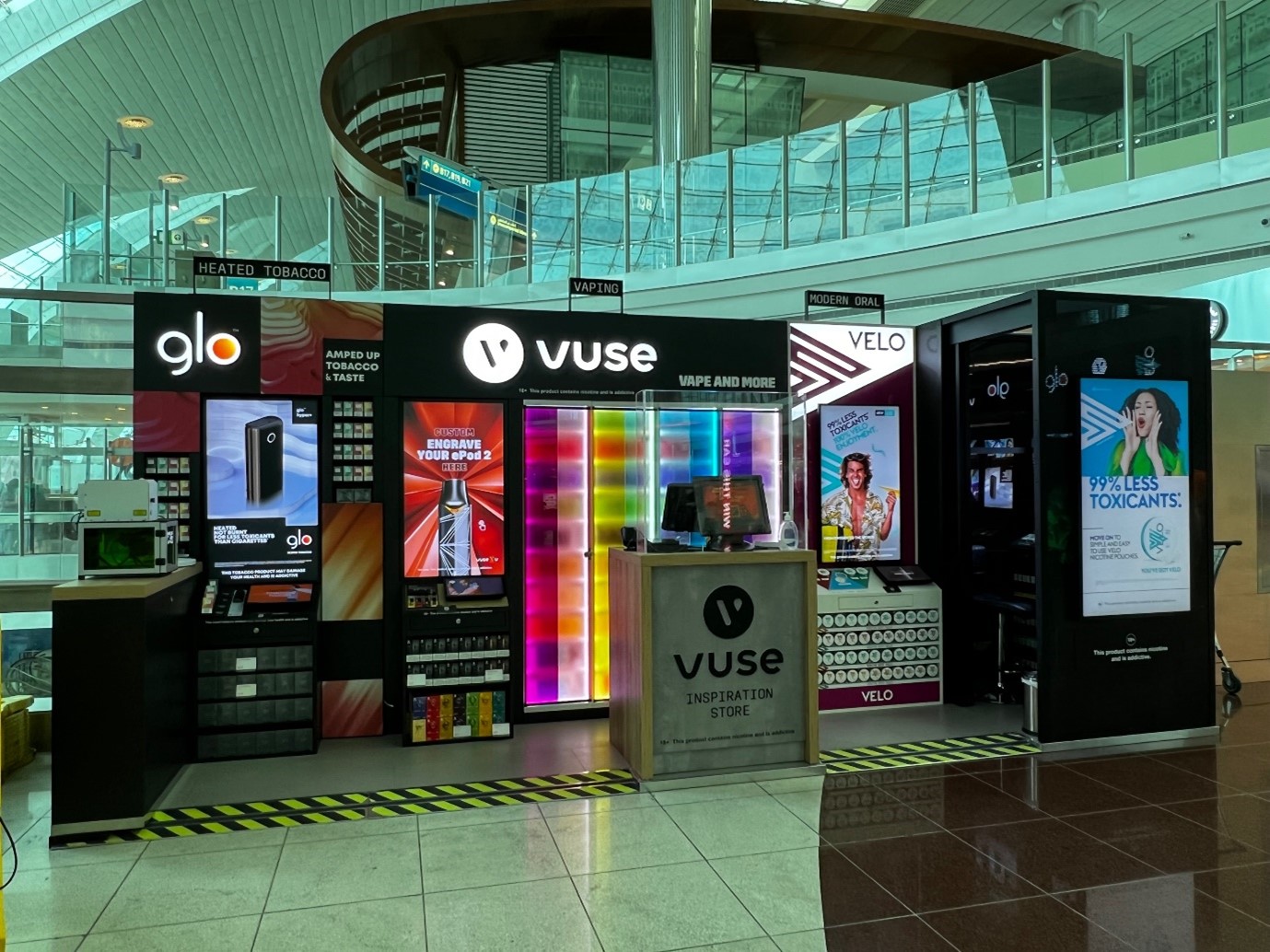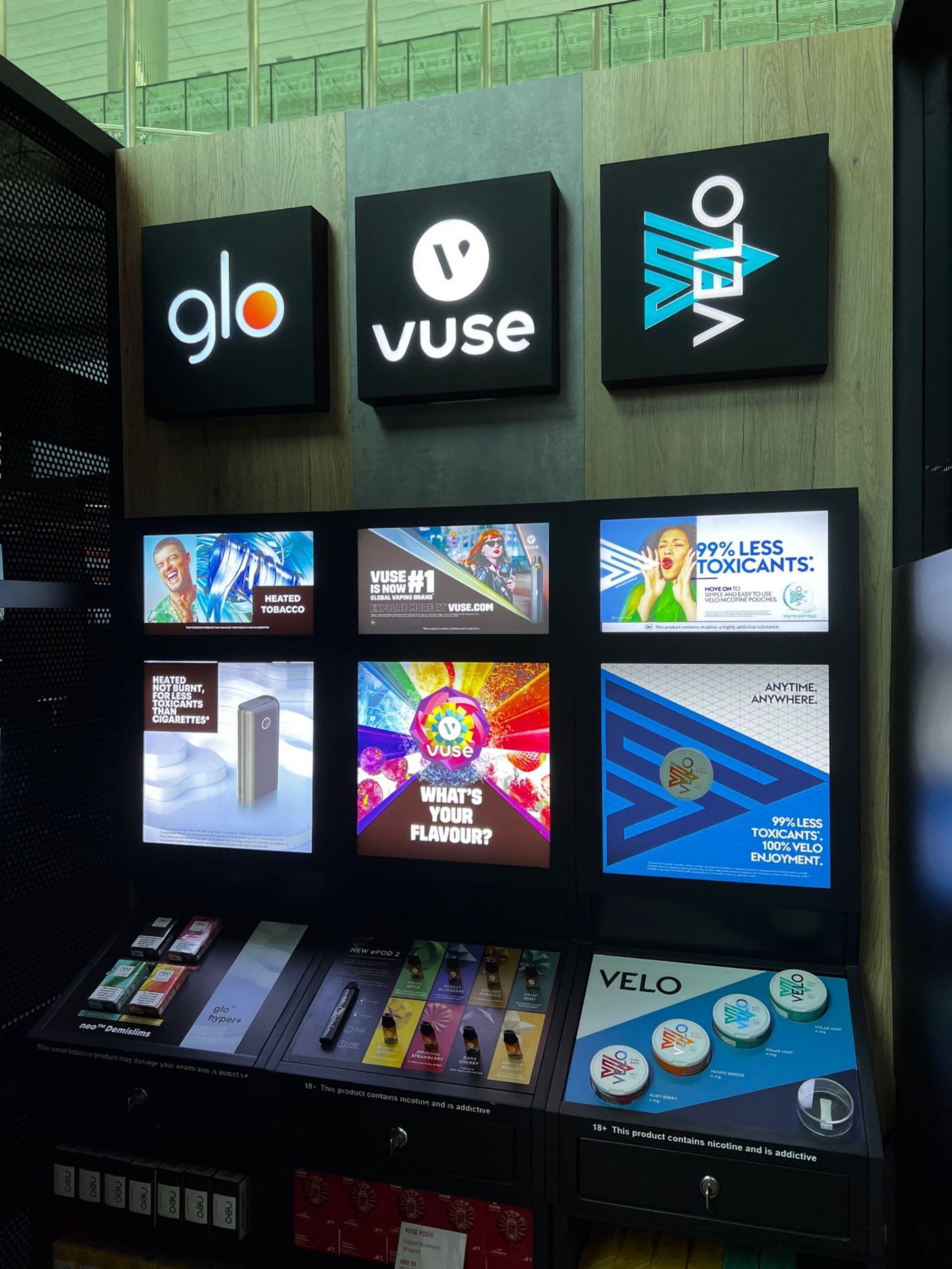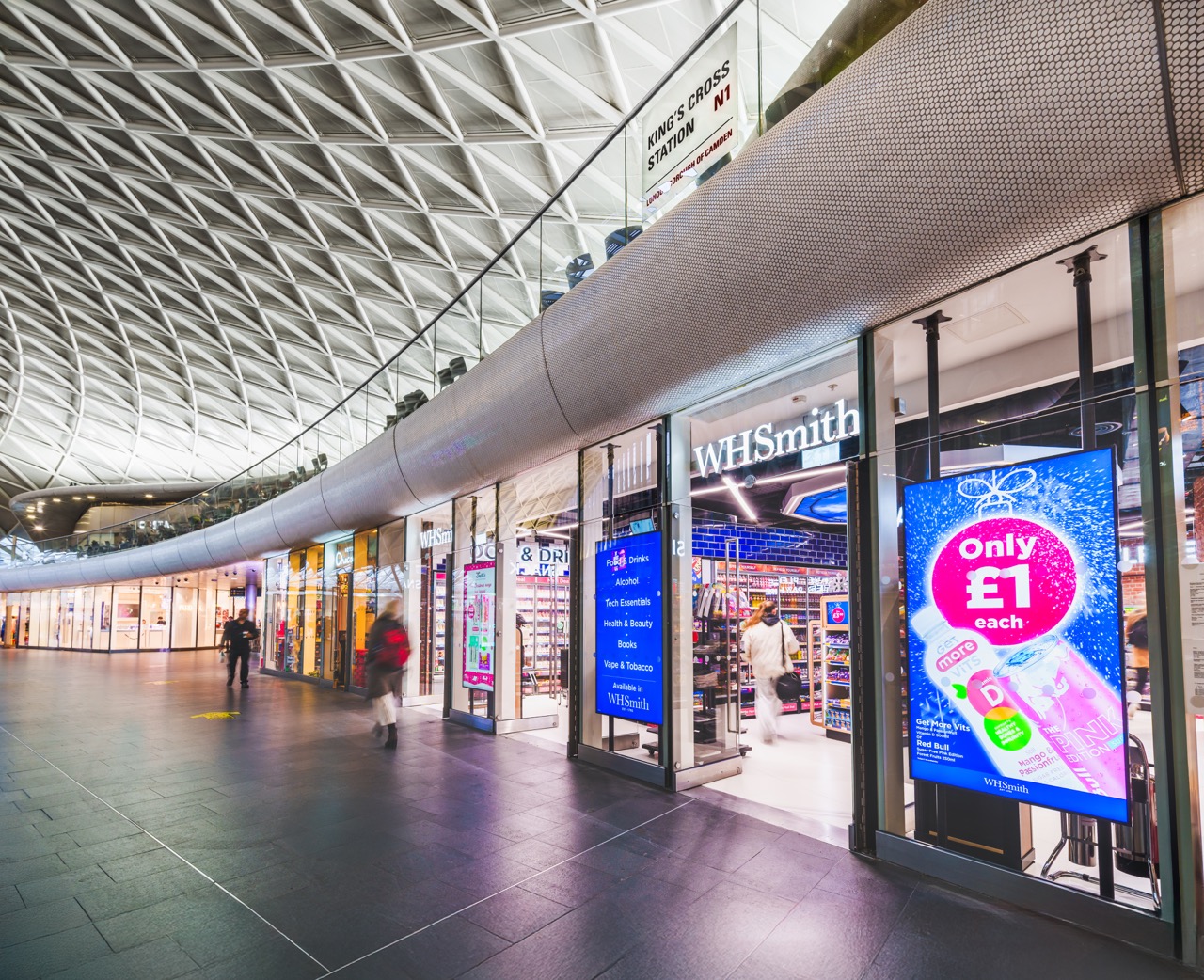
Introduction = BAT is a multi-category giant of the consumer goods business, a FTSE company that claims more than 150 million consumer interactions daily and distributes to over 11 million points of sale in some 175 markets. Besides its five most renowned traditional cigarette brands – Dunhill, Kent, Lucky Strike, Pall Mall and Rothmans – the 120 year-old British group owns and focuses intensively on a cluster of products with reduced-risk potential across multiple sub-sectors, including Vuse, glo and Velo.
Travel retail, for years a key channel to the group as a volume and value driver in its own right, is also a critical global brand showcase for these new-generation products. At the recent TFWA World Exhibition, Martin Moodie discovered more about BAT Global Travel Retail’s strategy and priorities in the channel in conversation with Greater China Cluster & Global Travel Retail General Manager Lars Kai; Head of Customer Management – Global Travel Retail Tony Clayton and Head of Brand Activation – Global Travel Retail Nicki Sheridan.
Being based in Hong Kong has given the BAT Global Travel Retail (GTR) leadership an acute insight into the pressures on the channel since the pandemic began in early 2020. With the Special Administrative Region having had strict travel and quarantine restrictions in place until 26 September this year, Hong Kong, like China as a whole, has been one of the worst-hit travel retail markets.
China has long been key to the tobacco giant’s global travel retail business (it represents a big chunk of Asia sales, which in turn constituted around half of turnover in the channel before the crisis) and so the travel constraints prompted by the pandemic have had a big impact on revenues.
But things are increasingly looking up, says Greater China Cluster & Global Travel Retail General Manager Lars Kai. “Like everyone, we’re comparing all of our numbers with the 2019 numbers before COVID and the good thing now after these years of pain is that finally we’re seeing recovery,” he says. “The main part of the recovery is coming from Europe and Middle East, so we’re about at an 80 percent index compared to 2019.
“That’s of course very good for the business and everybody’s very happy about it. The main challenge is still Asia, so we are still very cautious about overpromising what’s going to happen in the near future in the region. But we do hope that once China opens their borders that we’ll begin to see some movement in travel retail.”

There lies the US$64 million question. Or questions. When will China open up and how will Chinese travellers behave when it does? “Nobody has a definite answer,” Kai admits. And while most industry pundits predict any opening up will be phased rather than floodgate, no-one doubts it is a matter of when not if. With Japan, Taiwan and Hong Kong now open, Kai professes satisfaction with where the group is at in travel retail. Mainland China will be the icing on what is once again a sizable cake.

Is the company surprised by the speed and strength of the travel retail rebound globally? “It’s in line with what we thought was going to happen in Europe and the Middle East,” replies Head of Customer Management – Global Travel Retail Tony Clayton. “There are some ups and some downs in different locations with certain markets performing better than others. But the big one for us is about China opening as that will affect Asia in general, due to the high [pre-pandemic] Chinese pax numbers in different countries.”
Clayton says consumer dynamics have altered discernibly through the pandemic, something that is working in BAT’s favour as it seeks to pursue the company mantra of ‘A Better Tomorrow’ through reducing the health impact of its traditional cigarette business by switching smokers to potential reduced-risk products (PRRPs).
“There’s definitely been a shift in consumer behaviour,” he comments. “We’re seeing consumers that have become much more health focused. So, for us, in leading to A Better Tomorrow, this is about communicating our portfolio and being able to offer different options in the nicotine space.
Driving digital engagement
“Digital is also becoming very important for us. Traditional retail is always going to be there, but we’re also evolving into a different space now with more digital focus and greater digital impact. For example, with some of the pop-up stores we have done at places like Dubai and Frankfurt airports we have a multitude of different ways to engage the consumer. Such digital interactions give us the ability to showcase brands in a different way than just the traditional way of retailing.”
Head of Brand Activation – Global Travel Retail Nicki Sheridan underlines the point. “Digital is key,” she says. “It is critical to our transformation journey and really key for us to push our new categories forwards. We look at digital in a couple of ways: travel retail is obviously a unique channel in terms of consumer behaviour and how consumers interact and behave in that channel.
“We can’t ever look at digital strategy and activation in the same way we would in traditional retail. For example, we work with a lot of our travel retail customers to leverage their click and collect platforms. Many have very successful platforms and we supply them with brand content and product. But what’s more important is looking at how we utilise digital touchpoints within our activations. How do we leverage the power of digital advertising or personalisation of devices to really attract and engage consumers?
“That is the special point. You can really see it in Dubai and Frankfurt airports, which are good examples of our latest activations where people can get hands-on and personalise their own devices. That’s gold for us.
“Travellers are very comfortable now to just walk into a store and start playing around with an iPad or touching some of our digital touchpoints. Because it’s now intuitive to them, it has become part of consumer behaviour. That’s something we’ve seen much more post-COVID. We were a bit nervous that people wouldn’t want to engage as much after COVID but it’s totally the opposite – people are really keen to get hands-on and to touch and feel and experience themselves. And we utilise digital to do exactly that, to really bring the brands to life.”

Clayton expands on the theme, noting that in the wake of changing consumer preferences the company has to evolve and drive its brand and activation strategy. “Shopping behaviour is changing and consumers want more than just traditional shopping, they also want unique experiences. They want to be in an environment where it’s not just about the normal way of doing things but seeing things that are a little different in that virtual space.
“We will continue to keep striving to reinvent our retail environment and creating our next generation of pop-up stores – creating that kind of environment, meeting that consumer need and continuously evolving that space for our consumers.”
Towards ‘A Better Tomorrow’

If the uncertainty over when the Chinese business is BAT’s biggest challenge in the sector, the greatest opportunity lies in activations, Clayton says. “We’ve got a great showcasing opportunity in travel retail. We have some 2 billion passengers travelling in the industry and we have amazing airports such as Dubai and Frankfurt where we can do great activations. For us that’s our biggest opportunity – to be able to engage and drive our ‘A Better Tomorrow’ mission and our multi-category portfolio to all of those travelling consumers.”
The mantra of ‘A Better Tomorrow’ is integral to everything BAT does worldwide, including in travel retail, Kai emphasises. “That is our core statement for moving into the future. It’s about reducing the health impact of our business. We are a 120 year-old company so we’ve been producing cigarettes for a long time and it is not a secret that cigarettes do impose a harm.
“What we have done as a company is to try to evolve into transforming this industry totally. It is about providing a variety of products with the potential to reduce risks compared to cigarettes. And we’ve been able to come pretty far along that journey. It’s very easy to say that we want to move in that direction but we have really started to accelerate it. We already have a relatively strong footprint – we have vaping products and we have oral nicotine pouches [pouches that can be put in the mouth so the user gets the nicotine but which are smoke-free -Ed]

“We also have tobacco-heated products, where basically you heat [but not burn] the tobacco. All this is evidence that we’ve been working very hard over the past couple of years. We’ve also put in some very bold targets that we want to reach.”

Bold indeed. BAT wants 50 million of its consumers to have switched to PRRPs by 2030 and it plans to generate some £5 billion (US$5.8 billion) of net turnover through the category by 2025. “The cool thing and something that we’re very proud of is that already we are north of 20 million consumers using our reduced risk products,” Kai comments. “In travel retail we have a significant part to play in being able to emphasise that message, because we have so many travellers that will see it in airports.”
Today BAT is present in some 57 markets with new category products, impressive progress given that the first launch, in Japan, was as recent as 2018. “It’s very new and we’ve come a long way,” says Kai. “Now, with the rebound of travel, it’s a lot about consumer choice. With the COVID restrictions gone, people want to travel, it’s their choice to travel. They’ll go through the airport; they’ll choose what they want.
“Our mission here in travel retail is to present different options in the airports so that people can say, ‘Well, this is my choice. I can now choose something different than the traditional cigarette’. That is one of the core missions we have in global travel retail.”

Strong trade buy-in
How is retailer acceptance of that mission? After all, traditional cigarettes have long been a mainstay of the business, both in their own right and as a key footfall driver into stores. “That’s a very interesting question because we are still very new on this journey,” replies Kai. “So, with discussions between the retailers, it is about educating them that that is how our industry is changing. We are in the midst of that discussion with our retailers. But many of them are picking up that it is the right direction to go in.”
Clayton concurs, commenting, “Many of our customers in the industry understand the journey that we’re trying to go on. They are aware both of the role that tobacco has played and the importance of how we have created this multi-category platform offering choice – trying to move the consumer into an opportunity of less harmful products. So the buy-in from the trade is pretty strong.”
A diverse PRRP offering
As mentioned, BAT’s PRRP portfolio comprises three categories, vapour products; tobacco heating products (THP); and modern oral products, such as tobacco-free nicotine pouches and traditional oral products, including moist snuff and snus. The group has made huge strides across all sectors despite intense competition in the space.
“We’re building brands for the future,” says Clayton. “That’s our key mantra. Over time we’ve built three global new category brands. We have Vuse for vaping; we have glo for heated tobacco; and we have Velo for what we call modern oral nicotine pouches. Our portfolio is based on consumer insights backed by rigorous science and innovation. That’s one of our key points that we’re very clear on. It defines where we’re at.

“Vuse is the number-one vaping brand globally, which would indicate that there is obviously high consumer trust. In September, we published results of a one-year clinical study on glo showing that smokers who switched exclusively to glo have achieved significant and sustained improvements across several indicators of protecting harm. For us, Velo is all about driving expansion into different markets and offering something that is a purely smoke-free nicotine pouch-type product.”
Going big on activations
In July, underlining its commitment to PRRPs, BAT Global Travel Retail (GTR) launched what it dubbed an ‘Inspiration Store’ pop-up at Frankfurt Airport Terminal 1. The pop-up, in partnership with the Gebr. Heinemann/Frankfurt Airport joint venture Frankfurt Airport Retail and Frankfurt Media, showcases vaping brand Vuse to international travellers.
The ‘New Categories Next Generation’ concept takes insights from previous activations and is designed to engage with adult customers through an immersive, highly digitalised experience. The store features a dedicated team of brand ambassadors, an innovative sensorial flavour experience, as well as several interactive digital touchpoints and tablets with educational brand content. All this comes together to give travellers a highly digitalised journey, where they can learn about BAT’s Vuse brand, its reduced risk potential compared to smoking, and its innovative product range.

“The Inspiration Store in Frankfurt is our latest new category activation,” explains Sheridan. “We started our new categories acceleration and our transformation journey when we launched at Dubai International Airport with Dubai Duty Free in 2020 with a multi-category pop-up store.

“When we look at how we activate in a travel retail space, the fact that in a lot of our locations we bring all three categories into one location is very much a differentiator for us. It means that consumers can navigate and understand what each category is and what their benefits are, and why they would potentially be better for them than another option. That’s really important from a consumer perspective because these categories are still relatively new and there’s a lot of work that we need to do on educating consumers and explaining to them what their choices are.
 “When we launched in Dubai in 2020, it was the first big activation that we’d done like that. We have a lot of similar stores in our domestic markets but they’re mainly focused on one category. This was the first time we brought all three into one space. It was a game changer for us, but it was also a test and learn.
“When we launched in Dubai in 2020, it was the first big activation that we’d done like that. We have a lot of similar stores in our domestic markets but they’re mainly focused on one category. This was the first time we brought all three into one space. It was a game changer for us, but it was also a test and learn.
“We wanted to understand how consumers behave post-COVID but also what engages them. What do they like? What works in the space? We got a lot of insights and learning from that with a trial room where consumers can test the product before they make a purchase. We have a number of engaging digital touchpoints, device personalisation and so on.
“Then we took all of the insight and learnings from Dubai and rolled that out into our latest activation in Frankfurt. Frankfurt is very much a consumer-centric space. We have worked with our domestic markets and some of the insights agencies to understand consumer behaviour in an airport. Like what is it consumers want from retail activations and in this space? And we’ve built the store around those findings.
“So, in Frankfurt there is a sensorial experience where they can smell the different flavours of the Vuse. They can engrave their device through the digital touchpoints. And there are various different touchpoints where they can engage and understand what’s beneficial for them and also learn where they can purchase Vuse in their own markets.
“It’s been great. We’ve only been live for a few months, but the feedback that we’ve got from the consumers as well as Heinemann has been very, very beneficial. We’ve seen a lot of traffic and footfall going through, but a lot of engagement which is really important to us.”

With the success of the Dubai and Frankfurt activations, BAT Global Travel Retail plans to roll out similar innovations in other global hubs, Sheridan says. As it sizes up those airports, where is the ideal positioning for such pop-ups within a terminal or duty free store? In the heart of the tobacco department? Or should the new categories be positioned away from traditional cigarettes?
“I think standalone stores that are outside the specific tobacco section have more impact,” Sheridan replies. “It drives more awareness and visually it’s more impactful. A lot of the spaces that we choose are based on footfall going through the airports and consumer behaviour in those locations.
“We know consumers have around an hour and a half dwell time in an airport, so for us to be able to get them at the right opportunity on their journey is really important. But it’s not just the stores; when you look at all of the touchpoints end to end in a consumer journey, that’s really important for us now. A key learning that we’ve taken from Dubai is about leveraging things like Out of Home media, or the digital touchpoints along the consumer journey.”

Such platform and touchpoints also stimulate subsequent brand recruitment in domestic markets, Sheridan notes. “From a consumer perspective, you’re not just experiencing our brand as a one-off in the airport. When they leave the airport, our domestic markets can ensure that we retain those consumers and have a long term relationship with them.”
As an engrossing interview nears its end, I return to the subject of A Better Tomorrow. Convincing retailers is one thing but how about the consumer communication journey. How complex is it to lead them on that journey away from traditional cigarettes to less harmful products?
“It’s not an easy communication and it requires a lot of investment from our side,” Kai replies. “What Nicki just raised about Dubai and Frankfurt is a great example of how we’re trying to do it. Firstly, we’re shifting the communication to less risky products. And secondly, we are ensuring we have basic availability of less risky products on the shelves, because that’s where the consumers actually discover them.
“We are present in 57 countries, so that’s a pretty powerful message to send and the consumer can actually go and choose those products. Of course, we want to communicate much more but we do have rules and regulations in our industry that make it quite difficult. So, one of the methodologies we chose to do is the pop-up stores like in Frankfurt and Dubai. There’s a whole evolution process behind it. We have to learn from it, see how our consumers react to it and then decide what we can do within our limited space.”
Kai cites his home country of Japan as an example of how far BAT has come in a short time with PRRPs. One-third of the smoking population there has already converted to new category products. “That’s a huge milestone not only for us but for the industry itself. We have a responsibility to do our best within the field of new categories to say, ‘Well, this is our statement. This is what we want to move towards.’ And then the consumer has a choice. If they want to be very health conscious, the best thing is to just quit smoking completely.”
Travel retail plays a critical role in that overarching global mission, Clayton says. “For our accelerated journey into A better tomorrow, adult smokers have to understand what our new category products are. This is the role that travel retail can play. It allows us to communicate to our consumers around the different platforms that we’ve got and then allow them to make an informed choice across the breadth of our multi-category portfolio.
“Travel retail allow us to facilitate those conversations and have that communication with the consumer. That is a really important role for us. In airports you’ve got an average 1.5 hours dwell time with a relatively captive environment so that gives us a great opportunity to be able to communicate to our consumers.”
“Some of these categories are really important from a travel retail perspective because they are great in terms of that particular environment,” adds Sheridan. “With Velo, for example, if you are a smoker or a vaper, you can obviously have this on your flight.
“So it is great from a consumer perspective. We’ve got the right environment and the products that consumers want in those environments. So GTR is critical within our business.”

In his capacity as Global Travel Retail General Manager what would Kai change if he could about the industry? “It would be responsible marketing freedom because it is difficult to communicate our platforms,” he replies. “I think it is our responsibility to accelerate our communication about these products because it will definitely mean a big change for a lot of people.
“We are in the midst of this transformation into becoming a different company. One thing that would be very nice is if not only us but also the entire industry moves in the same direction. And I do feel that is the responsibility of the tobacco industry. If we all collectively go in that direction, we’ll make A Better Tomorrow not just for ourselves but for all of our businesses.”








